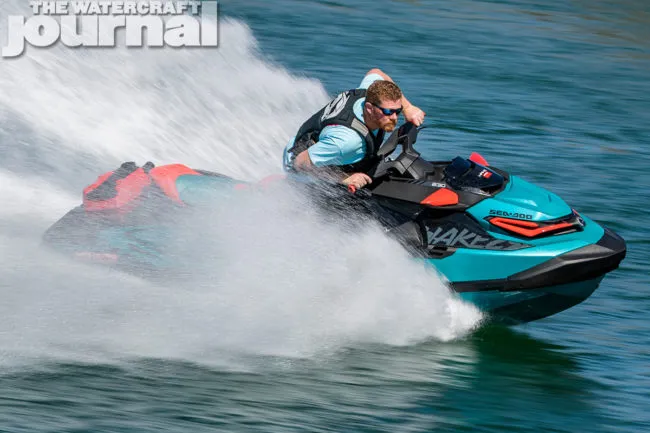Typically, our full-length personal watercraft reviews are…well, a little more lengthy. Admittedly, we had only a few hours aboard the all-new 2018 Sea-Doo Wake Pro 230, and while so much of the runabout is more or less identical to the RXT 230 and the GTX 230 – save for major features specific to the Wake Pro models, which we will discuss shortly – we didn’t feel it right to fluff and repackage a previous article as being something woven from whole cloth. (Particularly as we did zero towing with the Wake Pro 230.) So with the preamble out of the way, let’s share our excitement for the this machine:
To begin, the Wake Pro 230 rides on Sea-Doo’s all new ST³-platform. Pulling heavily from the popular-yet-9-year-old S³ platform, and a large portion of RXP-X’s T³ hull, the ST³ hull and deck are made using Sea-Doo’s CM-Tech (Closed Mold Technology). This not only alters how Sea-Doo makes its watercraft, but also permits for better automotive-grade paint finishes, as well as eliminating the irritating fibrous texture on the inside of the engine compartment – leaving only a smooth, somewhat chalky surface in its stead. The new machine is 135.9-inch long, 49.4-inch wide runabout that weighs in at 815-pounds (making it shorter and lighter than last year’s Wake Pro 215).
While the use of CM-Tech does manage to shave a little bit of weight, Sea-Doo Watercraft Global Product Manager James Heintz explained, “Most of the weight savings is attributed to the new sectioned two-piece seat. Gone is the big, heavy single-piece seat [that pivoted on a gas strut-powered hinge], replaced with this lighter two-piece seat that can be removed for single-person riding, or for lounging on the rear platform.” The new seat features the brand’s best iteration of Ergolock, sitting the rider and passenger deeper into the ski, 1.5-inches for the driver, and 3-inches for the rear passenger.
Of course, the 1,494cc four-stroke, 3-cylinder ACE 1500 is a perfect fit for the new hull, and includes some minor upgrades for 2018: a simplified CLCS (Closed Loop Cooling System), a more thermally-efficient ride plate, a larger oil cooler, and a sacrificial anode in the intercooler are all new for 2018. Producing 230 worth of supercharged horsepower, the Wake Pro 230 has little trouble reaching a top speed of 68.6mph. Best of all, performing minor services like oil changes requires removing just the driver’s seat; yet, for bigger jobs, a major engine access panel (held on by 13 torx head screws) reveals a massive access window into the cavernous engine compartment.
Interestingly, the same panel also incorporates both the ski tower screw-cap portal and LinQ system, including the attachment points for the sectional seat. Sea-Doo’s new LinQ system is new for 2018 and borrows heavily from BRP’s Can-Am and Ski-Doo categories: the LinQ system allows for the attachment and securing of a triad of accessories: a 4-gallon fuel can; a semi-rigid, 5.5-gallon storage bag; or a 4.2-gallon ice chest. (Each sold separately through Sea-Doo’s accessory line.) Moreover, the storage bag can attach atop the fuel caddy (nothing goes on top of the cooler). Each item is mounted to the deck via two pop-up attachment blocks that also can be snapped down for a flat surface.
And of course, there is a provision for the telescoping Wake tower for better towing of skiers and tubes. Included in the Wake package is the Speed-Based Ski mode (offering the pilot a series of acceleration curves to best launch a towable or skier), and the removable wake board rack – not to mention the exclusive Teal Blue Metallic and Lava Red colors and decals. The ST³ now offers an absolutely massive new deck, 366-square-inches worth. It’s also flat, only ever-so-slightly sloped downward, and terminates in a plastic molded-in tow eye hook and cleat combination.
Finally, the biggest feature on the new platform in Sea-Doo’s Direct Access Front Storage; a giant 27-gallon single basin located directly beneath the cockpit’s control panel. This integrates the 5-position tilt steering (which features completely redesigned toggle pads allowing for scrolling through Sport and Eco modes, and the high performance VTS settings). The analog-and-LCD digital dashboard; two heavy-duty hood release locks; and a smaller, secondary watertight, padded cell phone case. And while not standard equipment, Sea-Doo’s 100-watt BRP Premium Audio sound system – consisting of two 50-watt pressure washer-safe, all-weather speakers with an external playback control pad – is the world’s first Bluetooth-controlled PWC audio system. It’s a $700 option, and absolutely worth every penny.
Priced at $14,699, the 2018 Sea-Doo Wake Pro 230 is certain to be one of the more popular choices for folks looking for supercharged performance (but maybe not top of the line horsepower) from a full-sized 3-seater runabout, and who love radical paint schemes. Sure, an anemic 15.9 gallon fuel capacity leaves much to be desired – particularly if you’re looking to avoid multiple trips to the fuel dock – and we’ve found a little bit of premature wear-and-tear at a few spots, but the ST³ platform and its third-generation Ergolock seat is easily one of the most comfortable cockpits on a PWC to date. Toss in some pretty solid rough water handling, and you’ve got a one-two punch that is sure to draw folks in.
[Many complained about previous episodes of “Long Haul” being “too produced” with distracting music, voiceover and other quality production efforts. So we just uploaded a snippet of GoPro footage below. Enjoy. -Ed.]



















Hey Kevin, can you say where the premature wear-n-tear spots were?
The front lip of the seat, Sea-Doo’s EVA foam matting and ALL of the exposed black plastic quickly discolors and bleaches under the sun. (Keep your Sea-Doo covered at all times.)